- Home
- Robert K. Massie
Nicholas and Alexandra Page 19
Nicholas and Alexandra Read online
Page 19
Sometimes, impressed by the deference shown him, Alexis was rude. At six, he walked into the waiting room of his father’s study and found the Foreign Minister, Alexander Izvolsky, waiting to see the Tsar. Izvolsky remained seated. Alexis marched up to the Minister and said in a loud voice, “When the Heir to the Russian Throne enters a room, people must get up.” More often, he was gracious. To one of his mother’s ladies-in-waiting who had done him a favor, the Tsarevich extended his hand in an exact imitation of his father and said with a smile, “It is really nice of you, you know.” As he grew older, he became sensitive to the subtleties of rank and etiquette. At nine, he sent a collection of his favorite jingles to Gleb Botkin, the doctor’s son, who drew well. Along with the jingles he sent a note, “To illustrate and write the jingles under the drawings. Alexis.” Then, before handing the note to Dr. Botkin to take to Gleb, Alexis abruptly crossed out his signature. “If I send that paper to Gleb with my signature on it, then it would be an order which Gleb would have to obey,” the Tsarevich explained. “But I mean it only as a request and he doesn’t have to do it if he doesn’t want to.”
As Alexis grew older, his parents carefully explained to him the need to avoid bumps and blows. Yet, being an active child, Alexis was attracted to the very things that involved the greatest danger. “Can’t I have my own bicycle?” he would beg his mother. “Alexei, you know you can’t.” “May I please play tennis?” “Dear, you know you mustn’t.” Then, with a gush of tears, Alexis would cry, “Why can other boys have everything and I nothing?” There were times when Alexis simply ignored all restraints and did as he pleased. This risk-taking behavior, common enough among hemophiliac boys to be medically labeled the “Daredevil reaction,” was compounded of many things: rebellion against constant overprotection, a subconscious need to prove invulnerability to harm and, most important, the simple desire to be and play like a normal child.
Once, at seven, he appeared in the middle of a review of the palace guard, riding a secretly borrowed bicycle across the parade ground. The astonished Tsar promptly halted the review and ordered every man to pursue, surround and capture the wobbling vehicle and its delighted novice rider. At a children’s party at which movies had been shown, Alexis suddenly led the children on top of the tables and began leaping wildly from table to table. When Derevenko and others tried to calm him, he shouted gaily, “All grown-ups have to go,” and tried to push them out the door.
By deluging him with expensive gifts, his parents hoped to make him forget the games he was forbidden to play. His room was filled with elaborate toys: There were “great railways with dolls in the carriages as passengers, with barriers, stations, buildings and signal boxes, flashing engines and marvelous signalling apparatus, whole battalions of tin soldiers, models of towns with church towers and domes, floating models of ships, perfectly equipped factories with doll workers and mines in exact imitation of the real thing, with miners ascending and descending. All the toys were mechanically operated and the little Prince had only to press a button to set the workers in motion, to drive the warships up and down the tank, to set the church-bells ringing and the soldiers marching.”
Like his father, Alexis was enthralled by military pageantry. From birth, he had borne the title of Hetman of all the Cossacks and, along with his toy soldiers, toy forts and toy gups, he had his own Cossack uniform with fur cap, boots and dagger. In the summer, he wore a miniature uniform of a sailor of the Russian navy. As a child, he said that he wanted most to be like one of the ancient tsars, riding his white horse, leading his troops into battle. As he began spending more and more time in bed, he realized that he would never be that kind of tsar.
Alexis had an ear for music. Unlike his sisters, who played the piano, he preferred the balalaika and learned to play it well. He liked nature and kept a number of pets. His favorite was a silky spaniel named Joy, whose long ears dragged on the ground. From a circus the Tsar acquired an aged performing donkey with a repertory of tricks. When Alexis visited the stable, Vanka, the donkey, expected to find sugar in his master’s pocket; if it was there, he turned it out with his nose. In the winter, Vanka was harnessed to a sled and pulled Alexis about the park.
Once Alexis was presented with the rarest pet of all, a tame sable. Caught by an old hunter in the depths of Siberia, it had been tamed by the old man and his wife, who decided to bring it as a present to the Tsar. The couple arrived, having spent every kopeck on the long journey. After the palace authorities had checked by telegram with their home village to make sure that the two were not revolutionaries, the Empress was informed. An hour later a message came back, instructing the old man and woman to come with the sable “as quickly as possible. The children are wild with impatience.” Later the old hunter himself described to a palace official what had happened:
“Father Tsar came in. We threw ourselves at his feet. The sable looked at him as if it understood that it was the Tsar himself. We went into the children’s room. The Tsar told me to let the sable go and the children began to play with it. Then the Tsar told us to sit down on chairs. He began to ask me questions. What made me think of coming to see him … What things are like in Siberia, How we go hunting … [The sable, meanwhile, was racing around the room, pursued by the children, leaving a trail of ruin.] Father Tsar asked what had to be done for the sable. When I explained, he told me to send it to the Hunters village at Gatchina. But I said,
“ ‘Father Tsar, that won’t do. All the hunters will be wanting to sell the skin of my sable. They will kill it and say the animal had an accident.…’
“The Tsar said:
“ ‘I would have chosen a hunter I could trust. But perhaps after all you are right. Take it back with you to Siberia. Look after it as long as it lives. That is an order you have received from me.… But mind, don’t forget to look well after the sable; it’s my sable now. God be with you!’ ”
The old man was given a watch crested with the Imperial eagle and the old woman a brooch. They were paid generously for the sable and also given money to travel home. But the children were inconsolable. “There was no help for it,” they said. “Papa had made up his mind.”
Pets were only a substitute for what Alexis really wanted: boys his own age as playmates. Because of his hemophilia, the Empress did not want him to play often with the small Romanov cousins who appeared infrequently at the palace with their parents. She considered most of them rough and rude, and she was afraid that they would knock Alexis down while playing their games. His most constant companions were the two young sons of Derevenko the sailor, who played with Alexis while their father watched. If the play got rough, Derevenko growled and the three children obeyed immediately. Later, carefully selected young cadets from the military academy were instructed as to the danger involved and then brought to the palace to play with the Tsarevich.
More often, Alexis played with his sisters or by himself. “Luckily,” wrote Gilliard, “his sisters liked playing with him. They brought into his life an element of youthful merriment that otherwise would have been sorely missed.” Sometimes, by himself, he simply lay on his back staring up at the blue sky. When he was ten, his sister Olga asked him what he was doing so quietly. “I like to think and wonder,” said Alexis. “What about?” Olga persisted. “Oh, so many things,” he said. “I enjoy the sun and the beauty of summer as long as I can. Who knows whether one of these days I shall not be prevented from doing it?”
More than anyone else outside the family, Pierre Gilliard understood the nature of hemophilia and what it meant to the Tsarevich and his family. His understanding developed gradually. He came to Russia from Switzerland in 1904 at the age of twenty-five. In 1906, he began tutoring Alexis’s sisters in French. For six years, he came to the palace almost every day to tutor the girls without ever really knowing the Tsarevich. He saw the boy as a baby in his mother’s arms; later he caught glimpses of him running down a corridor or out in the snow riding his sled, but nothing more. Of Alexis’s disease the tutor
was almost completely ignorant.
“At times, his visits [to his sisters’ classroom] would suddenly cease and he would be seen no more for a long time,” Gilliard wrote. “Every time he disappeared, the palace was smitten with the greatest depression. My pupils’ [the girls] mood was melancholy which they tried in vain to conceal. When I asked them the cause, they replied evasively, ‘Alexis Nicolaievich is not well.’ I knew that he was prey to a disease … the nature of which no one told me.”
In 1912, at the request of the Empress, Gilliard began tutoring Alexis in French. He found himself confronted with an eight-and-a-half-year-old boy “rather tall for his age … a long, finely chiseled face, delicate features, auburn hair with a coppery glint, and large grey-blue eyes like his mother.… He had a quick wit and a keen, penetrating mind. He surprised me with questions beyond his years which bore witness to a delicate and intuitive spirit. Those not forced to teach him habits of discipline as I was, could quickly fall under the spell of his charm. Under the capricious little creature I had first known, I discovered a child of a naturally affectionate disposition, sensitive to suffering in others just because he suffered so much himself.”
Gilliard’s first problem was establishing discipline. Because of her love and fear for him, the Empress could not be firm with her son. Alexis obeyed only the Tsar, who was not always present. His illness interrupted his lessons for weeks at a time, sapping his energy and his interest, so that even when he was well he tended to laziness. “At this time, he was the kind of child who can hardly bear correction,” Gilliard wrote. “He had never been under any regular discipline. In his eyes, I was the person appointed to extract work from him.… I had the definite impression of his mute hostility.… As time passed, my authority took hold, the more the boy opened his heart to me, the better I realized the treasures of his nature and I began to feel that with so many precious gifts, it was unjust to give up hope.”
Gilliard also worried about the isolation which surrounded Alexis. Princes inevitably live outside the normal routine of normal boys and, in Alexis’s case, this isolation was greatly intensified by his hemophilic condition. Gilliard was determined to do something about it. His account of what happened—of the decision by Nicholas and Alexandra to accept his advice and of the anguish they and Alexis suffered when a bleeding episode ensued—is the most intimate and moving eyewitness account available of how life was really lived in the inner world of Tsarskoe Selo:
“At first I was astonished and disappointed at the lack of support given me by the Tsaritsa,” wrote Gilliard.… “Dr. Derevenko [coincidentally, the Tsarevich’s doctor had the same name as his sailor attendant, although the two were unrelated] told me that in view of the constant danger of the boy’s relapse and as a result of the religious fatalism developed by the Tsaritsa, she tended to leave the decision to circumstance and kept postponing her intervention which would inflict useless suffering on her son if he were not to survive.…”
Gilliard disagreed with Dr. Derevenko. “I considered that the perpetual presence of the sailor Derevenko and his assistant Nagorny were harmful to the child. The external power which intervened whenever danger threatened seemed to me to hinder the development of will-power and the faculty of observation. What the child gained possibly in safety, he lost in real discipline. I thought it would be better to give him more freedom and accustom him to resist the impulses of his own motion.
“Besides, accidents continued to happen. It was impossible to guard against everything and the closer the supervision, the more irritating and humiliating it seemed to the boy and the greater the risk that it would develop his skill at evasion and make him cunning and deceitful. It was the best way to turn an already physically delicate child into a characterless individual without self-control and backbone even in the moral sense.
“I spoke … to Dr. Derevenko, but he was so obsessed by fears of a fatal attack and so conscious of the terrible responsibility that devolved on him as a doctor that I could not bring him around to share my view. It was for the parents and the parents alone to take a decision which might have serious consequences for their child. To my great astonishment, they entirely agreed with me and said they were ready to accept all risks of an experiment on which I did not enter myself without terrible anxiety. No doubt they realized how much harm the existing system was doing to all the best in their son and if they loved him to distraction … their love itself gave them the strength to run the risk of an accident … rather than see him grow up a man without strength of character.… Alexis Nicolaievich was delighted at this decision. In his relations with his playmates, he was always suffering from the incessant supervision to which he was subject. He promised me to repay the confidence reposed in him.
“Everything went well at first and I was beginning to be easy in my mind when the accident I had so much feared happened without warning. The Tsarevich was in the classroom standing on a chair, when he slipped and in falling hit his right knee against the corner of some piece of furniture. The next day he could not walk. On the day after, the subcutaneous hemorrhage had progressed and the swelling which formed below the knee rapidly spread down the leg. The skin, which was greatly distended, had hardened under the force of the blood and … caused pain which worsened every hour.
“I was thunderstruck. Yet neither the Tsar nor the Tsaritsa blamed me in the slightest. So far from it, they seemed intent on preventing me from despairing.… The Tsaritsa was at her son’s bedside from the first onset of the attack. She watched over him, surrounding him with her tender love and care and trying a thousand attentions to alleviate his sufferings. The Tsar came the moment he was free. He tried to comfort and amuse the boy, but the pain was stronger than his mother’s caresses or his father’s stories and moans and tears began once more. Every now and then, the door opened and one of the Grand Duchesses came in on tiptoe and kissed her little brother, bringing a gust of sweetness and health into the room. For a moment, the boy would open his great eyes, around which the malady had already painted black circles, and then almost immediately, close them again.
“One morning I found the mother at her son’s bedside. He had had a very bad night. Dr. Derevenko was anxious as the hemorrhage had not stopped and his temperature was rising. The inflammation had spread and the pain was worse than the day before. The Tsarevich lay in bed groaning piteously. His head rested on his mother’s arm and his small, deadly white face was unrecognizable. At times the groans ceased and he murmured the one word, ‘Mummy.’ His mother kissed him on the hair, forehead, and eyes as if the touch of her lips would relieve him of his pain and restore some of the life which was leaving him. Think of the torture of that mother, an impotent witness of her son’s martyrdom in those hours of anguish—a mother who knew that she herself was the cause of those sufferings, that she had transmitted the terrible disease against which human science was powerless. Now I understood the secret tragedy of her life. How easy it was to reconstruct the stages of that long Calvary.”
* Today, at the first sign of severe bleeding, hemophiliacs are given transfusions of frozen fresh blood plasma or plasma concentrates. New non-habit-forming drugs are used to lessen pain. Where necessary, joints are protected by intricate plastic and light metal braces. Most of these developments in the treatment of hemophilia are quite recent. The use of plasma, for example, was a medical outgrowth of the Second World War, while the design of new lightweight braces is the result of new syntheses of metals and plastics. Hemophilia today is a severe but more manageable disease, and most hemophiliacs can survive the difficult years of childhood to live relatively normal adult lives.
CHAPTER TWELVE
A Mother’s Agony
HEMOPHILIA is as old as man. It has come down through the centuries, misted in legend, shrouded with the dark dread of a hereditary curse. In the Egypt of the Pharaohs, a woman was forbidden to bear further children if her firstborn son bled to death from a minor wound. The ancient Talmud barred circumcision in a family if two
successive male children had suffered fatal hemorrhages.
Because over the last one hundred years it has appeared in the ruling houses of Britain, Russia and Spain, it has been called “the royal disease.” It has also been called “the disease of the Hapsburgs”; this is inaccurate, for no prince of the Austrian dynasty has ever suffered from hemophilia. It remains one of the most mysterious and malicious of all the genetic, chronic diseases. Even today, both the cause and the cure are unknown.
In medical terms, hemophilia is an inherited blood-clotting deficiency, transmitted by women according to the sex-linked recessive Mendelian pattern. Thus, while women carry the defective genes, they almost never suffer from the disease. With rare exceptions, it strikes only males. Yet it does not necessarily strike all the males in a family. Genetically as well as clinically, hemophilia is capricious. Members of a family in which hemophilia has appeared never know, on the birth of a new son, whether or not the child will have hemophilia. If the child is a girl, the family cannot know with certainty whether she is a hemophilic carrier until she grows and has children of her own. The secret is locked inside the structure of the chromosomes.*
If modern science has made little progress in finding the cause of or a cure for hemophilia, it has achieved an extensive charting of the scope of the disease. Hemophilia follows no geographical or racial pattern; it appears on all continents, in all races at a statistical ratio of one hemophiliac among every 5,000 males. In the United States, there are 200,000 hemophiliacs. Theoretically, the disease should appear only in families which have a previous history of hemophilia. But today, in the United States, forty percent of all cases appearing have no traceable family history. One explanation for this is that the defective gene can remain hidden for as many as seven or eight generations. A more probable explanation is that the genes are spontaneously changing or mutating. What causes these spontaneous mutations, no one knows. Some researchers believe they are the result of new and rapidly changing environmental factors such as drugs or radiation. In any case, their number apparently is increasing.

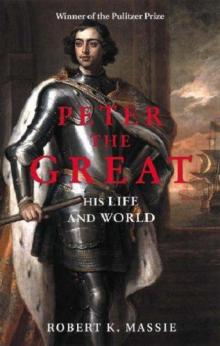 Peter the Great
Peter the Great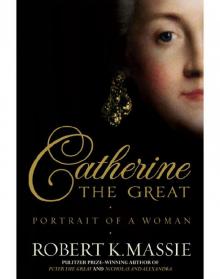 Catherine the Great
Catherine the Great Dreadnought
Dreadnought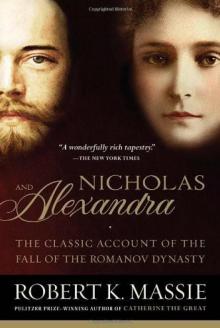 Nicholas and Alexandra: The Classic Account of the Fall of the Romanov Dynasty
Nicholas and Alexandra: The Classic Account of the Fall of the Romanov Dynasty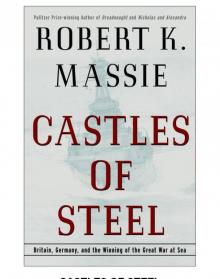 Castles of Steel
Castles of Steel Nicholas and Alexandra: The Tragic, Compelling Story of the Last Tsar and his Family
Nicholas and Alexandra: The Tragic, Compelling Story of the Last Tsar and his Family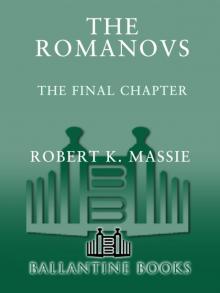 The Romanovs
The Romanovs Dreadnought, Britain, Germany and the Coming of the Great War
Dreadnought, Britain, Germany and the Coming of the Great War Nicholas and Alexandra
Nicholas and Alexandra